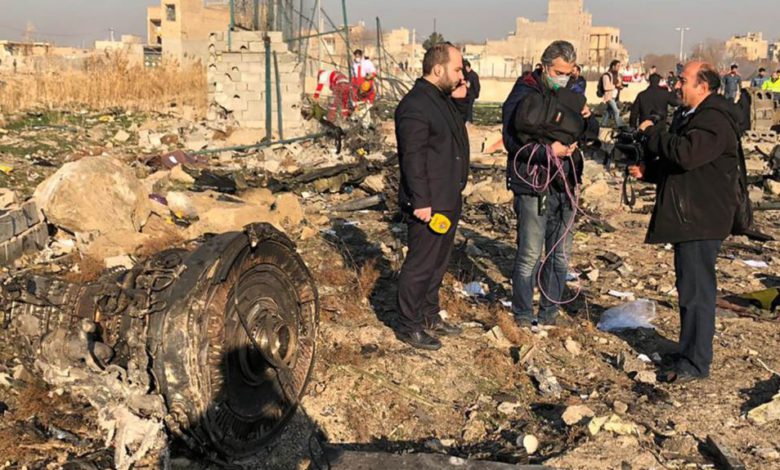Mechanical Failure? Pilot Error? No, Errant Missile May Have Downed Ukraine’s Flight PS752 Near Tehran

About five hours after Iran launched a volley of missiles at U.S. forces in Iraq, bringing the Middle East a step closer to war, Ukrainian International Airlines Flight PS752 took off into the predawn darkness from Tehran’s Imam Khomeini International airport.
On board were 176 people en route to Kyiv, where most planned to connect to further destinations, including Canada.
But just two minutes into the January 8 flight, as the Boeing 737-800 climbed to an altitude of 2,400 meters, it suddenly disappeared from radar.
It would crash two minutes later, killing everyone on board. The pilots did not communicate any trouble with the aircraft before its tragic demise.
That could be because there were no problems.
U.S. officials now say that it appeared the plane was shot out of the sky by an anti-aircraft missile launched by Iran’s own security forces.
The U.S. conclusion — one that could have serious consequences for Iran if true — contradicted a statement by officials in Tehran that the plane crashed due to a technical malfunction.
Reports from private risk consultancy companies, open-source investigators, and Western news media buttress Washington’s theory.
Ali Rabiei, an Iranian government spokesman, immediately denounced the U.S. conclusion, calling it a form of “psychological warfare.”
Missile Or Not?
Eyewitnesses on the ground — some recording video — recalled seeing a burning object falling from the sky on January 8, and bursting into flames as it hit the ground shortly thereafter.
As the sun rose, investigators picked through a field of debris, collecting luggage, toys, and body parts as they searched for clues to the cause.
The airline, and Boeing, said the plane appeared to be properly maintained. It had its most recent inspection just days before. And the pilots were experienced, with more than 23,000 combined hours operating a Boeing 737.
But even before investigators had much time to study the scene, Iranian officials claimed the crash was caused by technical problems.
The story was muddied almost immediately by contradictory information from, among others, the Ukrainian Embassy in Tehran, which posted a statement that said the crash was caused by engine failure.
It soon removed the statement from its website and, less than an hour later, put up a new one that did not mention such a cause.
As questions swirled about what actually happened, Iran said it would not turn over the flight cockpit recorder — known colloquially as the black box — to U.S.-based Boeing for investigation, a decision that ran contrary to commonly accepted practices for investigations of airline disasters.
Political and aviation analysts said it suggested that Tehran was potentially seeking to hide embarrassing aspects of the disaster.
Rabiei would later say that Boeing officials could come. Under United Nations’ rules, Boeing and U.S. aviation agencies have the right to participate because the plane was manufactured in America, Anthony Brickhouse, an aviation professor at Embry-Riddle Aeronautical University in Florida and a crash investigator, told RFE/RL.
Ukraine, which sent a team of 45 investigators to Tehran early on January 9, said one of the theories it would be investigating is a missile strike, a statement that drew rebuke from Ali Abedzadeh, the head of Iran’s civil aviation agency.
“Scientifically, it is impossible that a missile hit the Ukrainian plane, and such rumors are illogical,” Abedzadeh told Iran’s semiofficial ISNA News Agency.
Russian Tor Missile?
London-based risk consultancy IHS Markit published a brief report for clients on the morning of January 9 that concluded that Flight PS752 was “likely to have been shot down mistakenly by an IRGC-operated SA-15 missile,” referring to Iran’s elite Islamic Revolutionary Guards Corps.
SA-15, a NATO designation, is a Russian-built short-range, surface-to-air missile system commonly known as Tor. Russian news agencies have said Iran owns at least 29 such systems, and likely has more.
Several unidentified officials in Washington told media that U.S. intelligence had determined that it was “highly likely” that a missile had indeed downed Flight PS752, probably in error.
U.S. President Donald Trump, speaking to reporters at the White House shortly thereafter, said he had a terrible feeling about the incident, adding he did not believe it was a mechanical issue.
“It’s a tragic thing,” he said. “But somebody could have made a mistake — on the other side.”
Canadian Prime Minister Justin Trudeau also said that a missile was to blame.
Larry Vance, an investigator who served for more than two decades on Canada’s Transportation Safety Board, said the plane’s instantaneous loss of communication and control was more indicative of a bomb or missile.
“If it was a mechanical accident, man, it would be something quite unique,” Vance told RFE/RL.
He said he could not recall a crash with a similar sequence of events that was caused by mechanical malfunction.
“Imagine what type of engine event would have to happen in order for it to disable the airplane completely, make it unflyable. That is not an engine fire. That is more like an engine explosion. Those engines just don’t do that. There is no history of them exploding like that,” he said
U.S. Agency To Visit Tehran?
There were some signals that Iran may be willing to cooperate with the United States in the investigation.
Reports from Iran say that Tehran has invited the National Transportation Safety Board (NTSB) to join its investigation.
The NTSB is the independent U.S. government agency charged with probing civil aviation accidents in the United States.
The NTSB said in a statement that it has received notification of the crash from Iran, the formal process that gives the U.S. agency the right to seek participation in the investigation.
The NTSB said it has named an accredited representative to the case, but did not say when or if the person would be allowed to visit the site.



